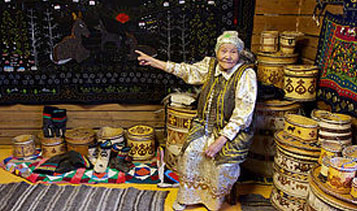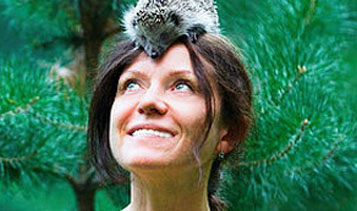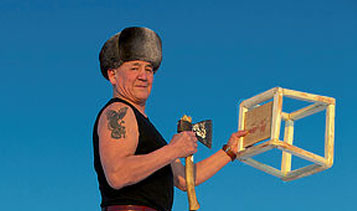War and Peace on the North Pole.
April 25, 2016 | Galya Morrell
Building a good ice station near the pole is tricky. Keeping it free of problems equally so.
The 2016 spring season at the North Pole opened as usual: on March 18, Russian helicopters started their search for a perfect ice floe, perfect enough to host the camp and a long runway which could handle multiple landings and take offs of heavy An-74s carrying crowds of adventure seekers from all around the world eager to leave their mark on the pole together with their equipment.
Building a good ice station near the pole is tricky. The team has to start immediately after the polar sunrise (and the Sun is up after six months of darkness on March 20), and then to do all their work quickly enough to allow for a month-long commercial season, until the ice starts disintegrating under the warming sun in the end of April.
At the beginning, there was nothing that could have predicted a disaster of either the climatic or political sort...
Tags
A «perfect» ice flow was located, manually checked by helicopter pilots who landed and drilled through the ice in a few spots (relying only on satellite images has shown problems before, so now the Barneo crew has a policy of double-checking). Then the first two tractorists were parachuted onto the chosen site along with their tractors.
«There are certain requirements for the ice floe,” says Victor Serov, the renowned polar explorer and the Barneo Ice Camp Expedition leader. “One of them is that the ice cannot be thinner than 80 cm. But to allow for the landing of the AN-74 it must be thicker, at least, 1m 40cm. This year the located floe site was had a thickness of 1 m 60cm to 2 m and the ice quality in general looked solid enough.”
On April 1st the runway was finished and ready for an inspection. The coordinates of the Barneo Ice Camp at that moment were 89° 16' 296" N 085° 24' 001" E. The technical flight was scheduled to take off and then that was exactly when the first signs of trouble revealed themselves. Small cracks covered the surface of the runway. The Barneo crew made a decision to fill them with water and to slightly change the direction of the runway. Of course, it took time. As a result, the first technical flight of the AN-74 took off on April 4th. The landings and take offs went well, so the construction of the camp near the runway began.
In the meantime, research scientists, marathoners, skiers, divers, newlyweds and other adventurers were impatiently counting the minutes while still at Longyearbyen on Svalbard. Then at that very moment, something unexpected happened: the “Flying Squad”, a squadron of Chechen special forces armed with AKMs modified to withstand the extreme cold temperatures was dropped onto the North Pole from an IL-76 airplane. The paratroopers jumped from an altitude of 2.5 kilometers to start a military exercise, which included a 20km long penetration into the enemy territory in search of the potential enemy as well as an assault and destruction of an “enemy command post”. And all of that in full gear and in temperatures averaging -40º Celsius.
The commandos from Northern Caucasus, while dressed in snow-camouflaged uniforms and laying down massive suppressive fire, managed to “stay invisible to the potential enemy.” Except for the glaring red “adventure style” sled, which gave away their position to the nearby polar bears and seals.
The Norwegians were infuriated, and then Mother Nature intervened. On April 5th the runway at Barneo cracked making transport aircraft take offs and landings impossible; thus taking the Chechen commandos hostage.
Only 650 m of a 1200 m runway remained. A search for another suitable ice floe was immediately started. The new tractors had to be dropped along with their drivers. And then, on April 7th, the new unfinished runway even cracked.
“This year we witnessed the combination of factors, such as wind, drift, currents and more that affected the ice in the area of the North Pole,” said Alexander Orlov, the founder of Barneo and the head of the Russian Geographical Society Expedition Center. “Is this a result of global warming? I would say, it is rather an effect of a climate change. The climate is definitely changing. For example, the temperatures on the North Pole this season were very low – down to -40º C versus the normal average -20º C for this time of the year. And the ice is solid just a few hundred km away to the South. It’s an equation with many unknown factors, and there is no easy answer.”
On April 7th the helicopters were airborne again to continue their search for a new ice floe. After 5 hours of flying and seeing a lot of open water and broken ice, they interrupted their mission and returned to base. At the same time, some of the stranded tourists at Longyearbyen started getting cold feet.
In the days to come, things got only worse. Mother Nature increased her fury: a snowstorm with zero visibility and very strong winds. Then to make things even more complicated, the Norwegians cancelled the AN-74 flight to Murmansk that was scheduled to airdrop the necessary equipment and supplies for a new runway. Due to a suspicious report in The Independent Barents Observer that Chechen special forces used Longyearbyen airport on Svalbard for transportation of personnel and equipment for an airborne drill close to the North Pole, the Norwegian tightened the documentation requirements for flights to/from Longyearbyen; in addition to the normal flight plan approval, a detailed list of passengers and cargo had to be submitted 48 hours prior to the scheduled departure. And if the departure fell on a Monday, that would mean 96 hours instead of 48.
A third, and then a fourth runways were built. They too developed excessive cracking. The grounded tourists in Longyearbyen had to decide what to do next. And the grounded Chechens on Barneo decided to switch their mission to humanitarian work from the military exercise; thus instead of AKMs they took shovels and ice-saws and worked hard building the new runways.
“It’s my third season on Barneo,” says Ismail Khamzin, the aeromobile tractorist from the Russian town of Penza. “It is never simple, but this year everything just went out of control. It was so cold; we worked at -40º C, while we were building all these runways”
In the days between the runways being closed down due to cracking, the marathon team of Richard Donovan managed to make it to Barneo, but only half of them. The second half was still stranded in Longyearbyen. Some others, like the 9th Last Degree Children Ski Expedition to the North Pole guided by the Russian polar explorer Matvey Shparo was still grounded in Moscow. Their hopes to make it to the Pole this year were quidkly vanishing.
And then, finally came a day when the elements and the Norwegian authorities became merciful for all those for whom reaching the North Pole was a mission of the heart.
The runners ran the marathon, the skiers climbed through hummocks and swam across the polynias, the divers went under the ice, and the hot-air-balloon navigated by David Kim Hempleman-Adams successfully made its 76 km journey to the Pole. Suddenly it became peaceful and relaxing as much as it can only be on the North Pole.
Anya Rozhkova, a 16 year old skier from Matvey Shparo’s children group told us after returning to Barneo Ice Camp from the Pole: “The North Pole has been my dream since I was 5 years old. This is the place where I would always want to come back, no matter what it takes.”
But what can it take? After this season, the future of Barneo is hidden in the fog. Some say it may be the last season for going to the North Pole via Svalbard. Russia, whose workers have been building and operating the Barneo ice camp for the last 15 years, is now looking eastward, exploring other options for reaching the Pole. Russia is currently renovating its Nagurskaya airfield on Alexandra Island; the upgrade should be finished by the end of 2016. It is located above 80°N, meaning that this airport is closer to the North Pole than the Longyearbyen airport.
My blogs:




Travels with the Nomad:
October 31, 2015 | Galya Morrell
Matters of Health:
June 10, 2015 | Galya Morrell
Russian Telegraph:
May 1, 2015 | Galya Morrell
Travels with the Nomad:
October 31, 2015 | Galya Morrell
Matters of Health:
June 10, 2015 | Galya Morrell
Russian Telegraph:
May 1, 2015 | Galya Morrell





